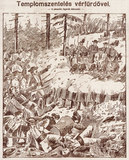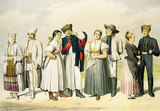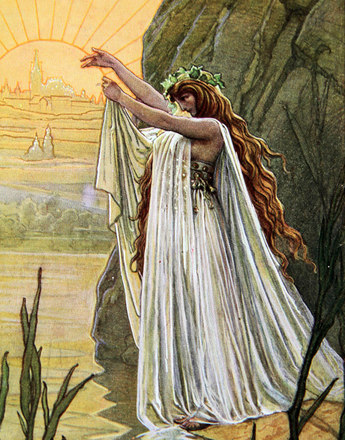-
Story The Slovaks
The Slovaks in the Struggle against Magyarisation: Lightning strikes over the Tatra Mountains
-

The Csernova incident; illustration from the newspaper Kis Újság, 1907
Copyright: Schloß Schönbrunn Kultur-und Betriebsges.m.b.H./Fotograf: Alexander E. Koller
Partner: Schloß Schönbrunn Kultur- und Betriebsges.m.b.H. -

H. Weber: “The peasant costumes: Valachs, Hungarians, Slavs, Germans”, colour lithograph from: Gabriel von Prónay: Skizzen aus dem Volksleben in Ungarn (Pest 1855)
Copyright: IMAGNO/Austrian Archives
This quotes the militant first words of the Slovakian national anthem, expression of the Slovaks’ endeavours to attain emancipation from the oppressive Hungarian-Magyar dominance in cultural and political affairs.
Nad Tatrou sa blýska, hromy divo bijú.
Zastavme ich bratia, ved’ sa ony stratia: Slováci ožijú.
To Slovensko naše posiaľ tvrdo spalo. Ale blesky hromu vzbudzujú ho k tomu, aby sa prebralo.
Translation:
Lightning strikes over the Tatra Mountains, the thunder wildly rolls.
Brothers, although they might hinder us, they will soon cease: the Slovaks are awakening.
Our Slovakia has slept until now. But the lightning and thunder shakes her and awakens her.
Especially after the 1867 Compromise when Hungary received generous rights of autonomy within the Dual Monarchy, the focus of the young Slovakian national movement was based on fighting the aggressive Magyarisation politics of the Hungarian state. Nevertheless, the positions varied in detail. The initially dominant idea of national unity with the Czechs – Czechoslovakism (ideology of a national union of Czechs and Slovaks combined with the demand for a unification of the settlement areas into one state) – was in the course of the nineteenth century increasingly clouded by divergent attitudes, one of which was the rejection of Czech cultural hegemony.
The advocates of Hungarian Slavism on the other hand professed a principle loyalty to the Hungarian state, which, however would have to be radically remodelled in terms of a federal state with various nationalities. But this trend, too, soon lost momentum because of the stubborn modus of Hungarian politics and the oppressive Magyar dominance.
The Slovakian representatives saw themselves united as a small nation fighting an overwhelming opponent, and which had no co-nationals abroad to step in as a protective power. Hence the Slovakian national movement showed a certain tendency to escape into a Utopian, Slavophile mindset with pro-Russian leanings.
The pressure of Magyarisation became more and more insistent in the last decades of the nineteenth century. This was demonstrated most markedly in school education: Slovaks had the constitutional right to study in their mother tongue, yet the Hungarians interpreted this in an extremely repressive way. Thus hardly any monolingual Slovakian elementary schools existed; they were mainly bilingual Hungarian-Slovakian with a distinct emphasis on the Hungarian element. This Magyarisation of school education came to a head in 1874/75 when the three hitherto existing public grammar schools with Slovakian as teaching language were closed down. Access to higher education in the public educational sector was now only possible for the Slovaks in Hungarian. Another heavy blow was the prohibition of national cultural associations like the foremost Slovakian cultural institution Matica Slovenská.
The Slovaks were also glaringly underrepresented in politics. Electorate boundaries were drawn deliberately so that scarcely any districts with a Slovakian majority might exist. Moreover the census franchise meant the exclusion of a majority of the small farmers and peasants and the markedly proletariat Slovakian society.
An important personality on the Slovakian political scene on the eve of the First World War was Milan Hodža (1878–1944), who aligned himself to the agrarian movement and belonged to the circle of political advisers of the heir presumptive Franz Ferdinand, known as an opponent of the Hungarian Compromise. Another important force was the Slovakian People’s Party (Slovenská ľudová strana) under the leadership of the Catholic priest Andrej Hlinka (1864–1938). Hlinka became a national martyr, particularly because of the tragedy of Černová in 1907. The Hungarian authorities forbade the priest to conduct the consecration ceremony for the local village church, since it was judged to encourage national agitation. The protest of the villagers was violently crushed by the Hungarian police, killing 15 people and injuring many more. Hlinka was declared a public enemy and condemned to many years in prison. The incident came to be known as the Massacre of Černová, internationally publicising the harsh situation of the Slovaks in Hungary.
Far less important at first was the Hlasist movement (from the magazine Hlas/ The Voice), which supported Czechoslovakism. Their adherents were recruited from the urban middle class, still weak in numbers. Although a minority in the mainly rural and small-town world of the Slovaks, these representatives of a common concept supporting a nation of Slovaks and Czechs eventually proved to be successful when Czechoslovakia was founded in 1918.
Translation: Abigail Prohaska
Gogolák, Ludwig: Ungarns Nationalitätengesetze und das Problem des magyarischen National- und Zentralstaates, in: Wandruszka, Adam/Urbanitsch, Peter (Hrsg.): Die Habsburgermonarchie 1848–1918, Band III: Die Völker des Reiches, Wien 1980, Teilband 2, 1207–1303
Holotík, L’udovít: Die Slowaken, in: Wandruszka, Adam/Urbanitsch, Peter (Hrsg.): Die Habsburgermonarchie 1848–1918, Band III: Die Völker des Reiches, Wien 1980, Teilband 1, 775–800
Křen, Jan: Dvě století střední Evropy [Zwei Jahrhunderte Mitteleuropas], Praha 2005
Rumpler, Helmut: Eine Chance für Mitteleuropa. Bürgerliche Emanzipation und Staatsverfall in der Habsburgermonarchie [Österreichische Geschichte 1804–1914, hrsg. von Herwig Wolfram], Wien 2005




